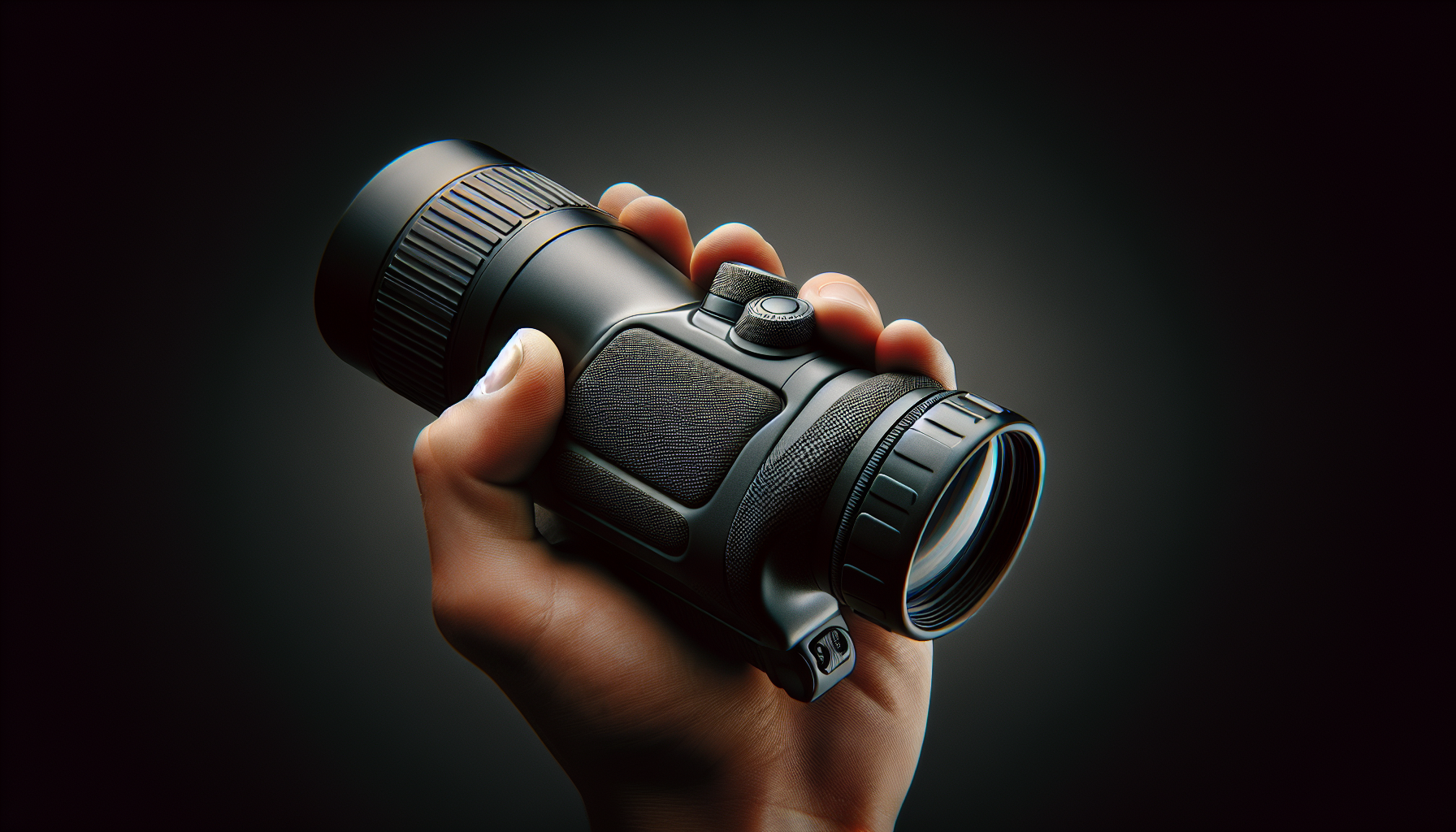Have you ever been out in nature, trying to spot a rare bird or observe distant wildlife, but found yourself struggling to see the details clearly? Well, fear not, because the answer to your problem might just be a spotting scope. But what exactly is a spotting scope, you may wonder? Simply put, it is a portable telescopic device that provides magnification and clarity for distant objects. It allows you to zoom in on faraway targets and experience the wonders of nature up close and personal. Whether you’re an avid birdwatcher, a wildlife enthusiast, or simply love exploring the great outdoors, a spotting scope can be your perfect companion for getting a closer look at the world around you. So, let’s embark on a journey to discover the amazing world of spotting scopes and unlock a whole new level of observation.
Definition of a Spotting Scope
A spotting scope is a versatile optical instrument that is commonly used in various fields such as birdwatching, wildlife observation, hunting, target shooting, and even astronomy. It is essentially a portable telescope that combines the magnification power of a telescope with the compactness and portability of a pair of binoculars.
Relevance in Different Fields
Spotting scopes play a crucial role in several fields due to their ability to provide detailed and clear views of distant objects. In birdwatching, for example, a spotting scope allows you to observe the intricate details of birds from a safe distance without disturbing them. Similarly, in wildlife observation, spotting scopes allow researchers and enthusiasts to study animals in their natural habitats without getting too close.
Hunters also benefit greatly from spotting scopes, as they can use them to locate game animals from afar and assess their size and behavior before making a shot. Shooters, whether practicing at a range or participating in competitions, use spotting scopes to examine their targets and assess their shot placements.
Furthermore, spotting scopes are also used in astronomy to observe celestial objects in greater detail than can be seen with the naked eye or even binoculars. They can reveal dazzling views of the moon, planets, star clusters, and even distant galaxies.
Why It’s Different from a Telescope
Although spotting scopes may resemble telescopes at first glance, there are notable differences between the two. While telescopes are primarily designed for astronomical purposes, spotting scopes are more versatile and cater to a wider range of applications.
Spotting scopes are typically designed with a smaller aperture, which means they gather less light compared to telescopes. However, they compensate for this by providing higher magnification and a wider field of view. This combination of features allows spotting scopes to excel in both terrestrial and celestial observations.
Additionally, spotting scopes are designed with a straight or angled body style, making them more user-friendly and comfortable for extended viewing sessions. Telescopes, on the other hand, usually have a fixed eyepiece and less emphasis on ergonomics.
Power and Magnification
Understanding Magnification
The magnification power of a spotting scope determines how much closer the viewed object will appear compared to the naked eye. Spotting scopes typically have a range of magnification options, usually denoted by two numbers separated by a dash (e.g., 20-60x). The first number represents the lowest magnification level, while the second number indicates the highest magnification.
It is important to note that higher magnification does not always mean better. While higher magnification can provide detailed views, it also narrows the field of view and makes the image shakier. Therefore, it is crucial to consider the intended use of the spotting scope and find a suitable balance between magnification and stability.
Ideal Magnification Range
The ideal magnification range for a spotting scope depends on its intended application. For birdwatching and wildlife observation, a lower magnification range of around 20-30x is often preferred. This allows for a wider field of view, making it easier to locate and track fast-moving targets.
On the other hand, for long-range shooting or astronomy purposes, a higher magnification range of 40x or above may be more appropriate. This enables users to observe fine details and distant objects more closely.
It is essential to remember that higher magnification also requires a sturdy tripod or mount to minimize image shake and provide a stable viewing experience.
Lens Quality
Importance of Lens Quality
The quality of the lenses used in a spotting scope greatly affects the overall performance and image clarity. High-quality lenses ensure that the light entering the scope is transmitted accurately and without distortion, resulting in sharp and detailed images.
When choosing a spotting scope, it is essential to consider the lens quality. Look for scopes with premium glass materials and multiple lens elements to minimize optical aberrations such as chromatic aberration or color fringing. This will result in images with accurate colors and improved contrast.
Lens Coating and Its Significance
Lens coatings are another crucial aspect to consider when evaluating the quality of a spotting scope. These coatings are applied to the lens surfaces to reduce reflections and maximize light transmission.
The most common types of lens coatings include single-coated, fully coated, multi-coated, and fully multi-coated. Single-coated lenses have a single layer of anti-reflective coating, while fully coated lenses have multiple coatings on all air-to-glass surfaces.
Multi-coated and fully multi-coated lenses feature multiple layers of anti-reflective coatings, providing superior light transmission and minimizing glare. These coatings enhance image brightness, clarity, and contrast, especially in challenging lighting conditions.
When shopping for a spotting scope, opt for models with multi-coated or fully multi-coated lenses for the best optical performance.
Field of View
Field of View Definition
The field of view refers to the extent of the observable area when looking through a spotting scope. It is typically measured in feet at a certain distance or as an angle of view in degrees.
A wider field of view allows you to observe a larger area at once, making it easier to track moving subjects or scan wide landscapes. Conversely, a narrower field of view results in a more zoomed-in and detailed view but limits the extent of the observable area.
Field of View and Spotting Scope Use
The ideal field of view largely depends on the specific application of the spotting scope. For birdwatching, wildlife observation, or other activities requiring tracking fast-moving subjects, a wider field of view is preferred to ensure that no critical moments are missed.
On the other hand, when engaging in target shooting or observing distant celestial objects, a narrower field of view may be desired to focus on specific details and to maximize magnification.
Consider your intended use and choose a spotting scope with an appropriate field of view to suit your needs.
Eyepieces and Focusing Mechanisms
Types of Eyepieces
Spotting scopes come with interchangeable eyepieces, allowing users to customize the magnification and field of view according to their preferences. There are various types of eyepieces available, including fixed magnification, zoom, wide-angle, and long-eye relief eyepieces.
Fixed magnification eyepieces offer a predetermined magnification level and are usually more affordable. Zoom eyepieces, on the other hand, provide a range of magnification levels that can be adjusted by rotating the eyepiece. These versatile eyepieces offer convenience but may sacrifice some optical quality compared to fixed magnification options.
Wide-angle eyepieces provide a wider field of view, enhancing the overall viewing experience. Long-eye relief eyepieces are designed for those who wear glasses, as they allow users to see the full field of view without having to press their eyeglasses against the eyepiece.
Basics of Focusing
Focusing mechanisms in spotting scopes allow users to adjust the image sharpness according to their distance from the observed subject. There are two primary focusing mechanisms found in spotting scopes: the focusing knob and the helical focus wheel.
The focusing knob is typically located near the eyepiece and is used for coarse adjustments, while the helical focus wheel is usually found on the main body of the scope and allows for fine adjustments.
When using a spotting scope, start by using the focusing knob to bring the image into approximate focus. Then, fine-tune the focus using the helical focus wheel for optimal clarity.
How Eyepieces and Focusing Mechanisms Affect Sight
The choice of eyepiece and focusing mechanism can greatly impact the viewing experience with a spotting scope. Different eyepieces offer varying levels of magnification, field of view, and eye comfort, allowing users to tailor their observations to their preferences.
The focusing mechanism determines how easily and accurately the image can be focused. Smooth and precise focusing mechanisms help in achieving crisp and clear images, while poorly designed mechanisms may result in frustration and missed viewing opportunities.
Consider your specific needs and preferences, and choose a combination of eyepieces and focusing mechanisms that will enhance your overall sighting experience.
Prism Design and Material
Prism Designs in Spotting Scopes
Prisms are an essential component of spotting scopes as they help in correcting the orientation of the image and folding the optical path within the scope. There are two common prism designs used in spotting scopes: roof prisms and porro prisms.
Roof prisms are commonly used in compact and lightweight spotting scopes. They allow for a straight and compact body design, making them easier to handle and carry. However, roof prisms tend to be more complex and require higher manufacturing precision, which can result in higher costs.
Porro prisms, on the other hand, are utilized in larger and wider spotting scopes, often with an angled body design. Porro prisms provide excellent image quality and are generally more affordable compared to roof prisms. However, they tend to be bulkier and heavier, making them less portable.
Materials Used in Prisms
Prisms in spotting scopes are typically made from either glass or Bak-4 glass. Bak-4 glass is considered superior due to its higher refractive index, which minimizes light loss and ensures superior image quality.
When choosing a spotting scope, consider models that utilize Bak-4 prisms to maximize light transmission and improve image clarity.
Role of Prism in Image Clarity
The quality of the prism directly impacts the image clarity and overall optical performance of a spotting scope. High-quality prisms minimize light loss, improve contrast, and eliminate distortions, ensuring that the observed images are sharp and true to life.
When evaluating different spotting scopes, pay attention to the prism quality as it greatly affects the perceived image clarity and detail.

Body Style
Straight Body Spotting Scopes
Spotting scopes come in two main body styles: straight and angled. Straight body spotting scopes have an inline design, meaning the eyepiece is aligned with the objective lens. This design allows for a more intuitive and direct approach to spotting and tracking objects.
Straight body spotting scopes are popular in situations where quick target acquisition and following moving subjects are essential. They also provide a more comfortable viewing experience when the user can set up the spotting scope at a similar height to their eye level.
Angled Body Spotting Scopes
Angled body spotting scopes have the eyepiece set at a 45-degree or 90-degree angle from the objective lens. This angled design offers greater versatility and allows users to comfortably observe objects at different elevations without straining their necks or assuming awkward positions.
Angled body spotting scopes are favored for activities that involve long-duration observations, such as birdwatching and astronomy. They also facilitate sharing the viewing experience among multiple users, as the angled eyepiece can be easily adjusted to accommodate different heights.
When choosing between straight and angled body styles, consider your intended use and personal preference to ensure the most comfortable and enjoyable viewing experience.
Tripods and Mounts
Need for Sturdiness
Using a spotting scope handheld for extended periods can cause arm fatigue and result in instability, resulting in shaky images. To overcome this, tripods and mounts are essential accessories for spotting scope users. They provide stability and allow for longer and more comfortable viewing sessions.
A sturdy tripod or mount ensures that the spotting scope remains steady, minimizing vibrations and maintaining a clear image. Investing in a high-quality tripod or mount is crucial for optimal viewing and capturing steady images or videos through the spotting scope.
Choosing the Right Tripod
When selecting a tripod for your spotting scope, consider its stability, weight capacity, and portability. Look for tripods made from lightweight yet sturdy materials such as aluminum or carbon fiber. Adjustable height and leg angles are also desirable features to accommodate different terrain and viewing positions.
Additionally, quick-release plates and robust locking mechanisms make it easier to attach and secure the spotting scope onto the tripod quickly and securely.
Role of Mounts in Spotting Scopes
Spotting scopes can be further stabilized using mounts, which help in fine-tuning the positioning and movement of the scope. There are various types of mounts available, including fluid heads, ball heads, and pan-tilt heads.
Fluid heads are preferred for smooth and controlled panning and tilting movements, making them suitable for tracking moving subjects. Ball heads offer quick and precise adjustments in any direction, while pan-tilt heads allow for separate control of horizontal and vertical movements.
Choosing the right mount depends on your specific needs and the type of movements you anticipate while using the spotting scope.

Care and Maintenance of Spotting Scopes
Cleaning the Spotting Scope
Proper maintenance and cleaning of your spotting scope are essential for ensuring its longevity and optimal performance. To clean the scope, first remove any dust or debris with a soft brush or air blower. Next, use a lens cleaning solution or lens wipes specifically designed for optical surfaces to gently clean the lenses.
Avoid using harsh or abrasive cleaning materials, as they can scratch or damage the lens coatings. Additionally, be cautious while handling the scope, ensuring your hands are clean and free from oils or dirt that can transfer onto the lenses.
Proper Storage Methods
When not in use, store your spotting scope in a dry and dust-free environment. It is recommended to keep the scope in a padded case or bag to protect it from accidental impacts or scratches.
Ideally, store the scope in a temperature-controlled area to avoid extreme temperature fluctuations that can damage the optics and other components of the scope.
Regular Maintenance Practices
In addition to regular cleaning, it is important to perform routine maintenance on your spotting scope. Check for any signs of wear or damage, such as loose screw fittings or degraded lens coatings. If necessary, consult the manufacturer’s instructions or seek professional servicing to address any issues.
Regularly inspecting and maintaining your spotting scope will ensure its reliability and longevity, allowing you to enjoy clear and crisp views for years to come.
Choosing the Right Spotting Scope
Factors to Consider
When selecting a spotting scope, several factors should be considered to ensure the best fit for your specific needs. The intended application, desired magnification range, lens quality, and portability are all important aspects to factor in.
Additionally, consider your budget, as spotting scopes can vary significantly in price depending on their features and specifications. While it is important to invest in a quality scope, there are options available to suit different budgets and requirements.
Recommended Brands and Models
Several reputable brands in the optics industry produce high-quality spotting scopes. Some well-regarded brands to consider include Swarovski, Leica, Zeiss, Vortex, Nikon, and Celestron, among others. These brands offer a range of models with varying features, magnification options, and price points.
It is advisable to research and read reviews to identify specific models that have received positive feedback from users in your desired field of application. Additionally, consider seeking expert advice from experienced users or professionals to guide your decision-making process.
Where to Buy a Spotting Scope
Spotting scopes are available at various brick-and-mortar retail stores specializing in optics, outdoor gear, or photography. You can also find a wide selection of spotting scopes online from reputable retailers and manufacturers’ websites.
When purchasing online, ensure that the seller or website is authorized and reputable. Read customer reviews, compare prices, and consider the warranty and return policies before making a final decision.
Remember to choose a reliable source that offers genuine products and provides good customer service to ensure a satisfactory buying experience.
In conclusion, a spotting scope is a valuable tool for various fields and activities, providing detailed and clear views of distant objects. By understanding the importance of factors such as magnification, lens quality, field of view, eyepieces, prisms, body style, tripods, and maintenance, you can make an informed decision when choosing the right spotting scope for your needs. Consider the specific requirements of your intended application, consult trusted reviews and recommendations, and explore reputable brands and models to find the perfect spotting scope that will enhance your observation and enjoyment of the great outdoors.




